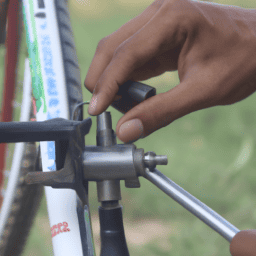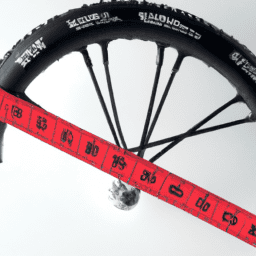Is the braking performance of your bike not up to par? No need to worry, as this article will walk you through the steps of adjusting rim brakes on a bicycle.
Just like a finely-tuned machine, your brakes require regular maintenance to ensure optimal performance and safety. By understanding the components, gathering the necessary tools, and following precise steps, you’ll be able to fine-tune your rim brakes, align the pads, and make any necessary adjustments.
Get ready to bring your braking power back to its peak!
Key Takeaways
- Regularly inspect and maintain brake pads to ensure continued performance and safety.
- Look for signs of uneven wear or thinness in brake pads and replace them if necessary.
- Troubleshoot common issues such as misalignment or worn-out pads by sanding them or replacing them if needed.
- Clean rims regularly and check the tension of the brake cable to improve brake performance.
Understanding the Components of Rim Brakes
To understand the components of rim brakes, you’ll need to familiarize yourself with the brake lever, brake caliper, brake pads, and brake cable.
Rim brakes are a common type of bicycle braking system, as opposed to disc brakes. Rim brakes work by applying pressure to the rim of the wheel to slow down or stop the bicycle.
There are different types of rim brakes, including caliper brakes, cantilever brakes, and V-brakes, each with their own advantages and disadvantages.
Caliper brakes are lightweight and aerodynamic, but they can be less powerful.
Cantilever brakes offer good tire clearance and mud shedding, but they can be complex to adjust.
V-brakes provide strong stopping power, but they require special brake levers.
Now that you understand the components of rim brakes, let’s move on to gathering the necessary tools.
Gathering the Necessary Tools
First, make sure you have all the tools you need for the job. Here are five essential tools you’ll need for adjusting rim brakes on a bicycle:
- Adjustable wrench: This tool will come in handy for loosening and tightening nuts and bolts.
- Allen wrench set: Different sizes of Allen wrenches will be needed to adjust various brake components.
- Screwdriver: A Phillips or flathead screwdriver will be necessary for making fine adjustments.
- Brake pad alignment tool: This tool ensures that your brake pads are properly aligned with the rim.
- Lubricant: Use a bike-specific lubricant to ensure smooth and efficient brake operation.
Choosing the right brake pads is crucial for optimal braking performance. Look for pads that are compatible with your rim material and provide the desired level of stopping power. Additionally, proper lubrication techniques will help your brakes operate smoothly and prevent squeaking.
Once you have the necessary tools, it’s time to move on to checking brake pad alignment.
Checking Brake Pad Alignment
Next, take a look at the alignment of your brake pads. It is important to regularly check the alignment to ensure optimal braking performance.
Start by observing the brake pads and look for signs of wear. If the pads are significantly worn or damaged, they should be replaced before adjusting the alignment.
To check the alignment, squeeze the brake lever and examine how the pads make contact with the rim. They should make even contact on both sides of the rim. If one side is closer to the rim than the other, you will need to adjust the alignment.
This can be done by loosening the brake pad bolt and repositioning the pad until it makes even contact. Once the alignment is correct, you can move on to adjusting the brake pad clearance for optimal braking efficiency.
Adjusting the Brake Pad Clearance
Now, it’s time to fine-tune the space between the brake pads for optimal braking efficiency. To adjust the brake pad clearance, follow these steps:
- Loosen the brake pad mounting bolts using a 5mm Allen wrench.
- Position the brake pads so that they are equidistant from the rim, ensuring that there is a small gap between the pad and the rim.
- Tighten the brake pad mounting bolts, making sure they are secure but not overly tight.
Proper brake pad positioning is crucial as it affects the overall performance of your brakes. If the pads are too far from the rim, you may experience reduced braking power. On the other hand, if the pads are too close, they may rub against the rim, causing premature wear.
With the brake pad clearance adjusted, we can now move on to aligning the brake pads and rim to ensure optimal braking performance.
Aligning the Brake Pads and Rim
To properly align the brake pads and ensure optimal braking performance, you’ll need to follow these steps. First, start by checking the brake pad wear. If the pads are worn beyond the recommended thickness, it’s time to replace them. Next, loosen the mounting nut on the brake pad and position it correctly against the rim. Make sure the pad is aligned with the rim’s braking surface. Once aligned, tighten the mounting nut securely. Repeat this process for the other brake pad. To help visualize this, refer to the table below:
| Steps | Brake Pad 1 | Brake Pad 2 |
|---|---|---|
| 1 | Check wear | Check wear |
| 2 | Loosen mounting nut | Loosen mounting nut |
| 3 | Position against rim | Position against rim |
| 4 | Align with braking surface and tighten nut | Align with braking surface and tighten nut |
Now that the brake pads are aligned, we can move on to adjusting the brake cable tension.
Adjusting the Brake Cable Tension
You can fine-tune the tension of the brake cable for optimal braking performance.
To adjust the brake cable tension, start by locating the adjusting barrel on the brake lever. Turn the barrel clockwise to increase tension or counterclockwise to decrease tension.
It’s important to find the right balance, as too much tension can cause the brakes to engage too quickly and too little tension can result in ineffective braking.
Troubleshooting brake squeal is another key aspect of adjusting the brake cable tension. If you hear squealing noises when braking, it may indicate that the brake pads are not properly aligned with the rim. In this case, adjusting the tension of the brake cable can help resolve the issue.
With the brake cable tension properly adjusted, you can move on to testing the brakes and making fine-tuning adjustments for optimal performance.
Testing the Brakes and Making Fine-Tuning Adjustments
Now that we’ve adjusted the brake cable tension, it’s time to test the brakes and make any necessary fine-tuning adjustments.
To ensure proper functionality, it’s crucial to conduct the bedding process for the brake pads. This process involves applying gradual pressure to the brake levers and squeezing them firmly multiple times. By doing so, the brake pads will effectively mate with the rim’s braking surface, optimizing their performance.
As you test the brakes, pay attention to any unusual noises or resistance. If the brakes feel spongy or the stopping power is insufficient, you may need to adjust the cable tension or inspect the brake pad wear.
It’s important to regularly check the brake pad wear and replace them if they are worn down beyond the recommended thickness. Properly bedding in new brake pads is essential for smooth and safe braking.
Properly Bedding in New Brake Pads
Once the brake pads are properly installed, it’s important to gradually apply pressure to the brake levers multiple times to ensure optimal performance. This process, known as bedding in brake pads, helps transfer a thin layer of brake pad material onto the rim’s braking surface, enhancing braking power and reducing squeaking.
To properly bed in new brake pads, follow these steps:
- Start by riding at a moderate speed and gently squeezing the brake levers to engage the pads against the rim.
- Apply increasing pressure to the brake levers, gradually increasing the force with each squeeze.
- Repeat this process around 20 times, allowing the brake pads to heat up and create a smooth, even braking surface.
Choosing the right brake pads is crucial for optimal performance. Consider factors such as the type of rim material and riding conditions to select pads that offer the best braking power and modulation.
With the brake pads properly bedded in, it’s essential to perform regular maintenance and inspections to ensure continued performance and safety.
Regular Maintenance and Inspection Tips
Regular maintenance and inspections are key to ensuring the continued performance and safety of your bike’s braking system. It is important to follow a maintenance schedule to keep your rim brakes in optimal condition.
One crucial aspect of maintenance is regularly checking brake pad wear. Over time, brake pads can become worn down and lose their effectiveness. To inspect the brake pads, remove the wheel and examine the pads for any signs of uneven wear or excessive thinness. If the pads are worn down beyond the recommended thickness, it is essential to replace them immediately. Additionally, check for any debris or dirt buildup on the brake pads and clean them if necessary.
By staying on top of regular maintenance and inspections, you can ensure that your rim brakes are functioning properly and safely.
Moving on to troubleshooting common issues with rim brakes…
Troubleshooting Common Issues with Rim Brakes
To troubleshoot common issues with your brake pads, start by checking for any squeaking or squealing sounds when you apply the brakes. This can indicate that the brake pads are worn out or not aligned properly.
To fix this, you can try sanding the brake pads lightly to remove any glaze or residue. Additionally, make sure that the pads are properly aligned with the rim and that they are making full contact when the brakes are applied.
If the squealing persists, you may need to replace the brake pads altogether. Another tip for improving brake performance is to clean the rims regularly to remove any dirt or debris that may affect the braking power.
Lastly, check the tension of the brake cable and adjust it if necessary to ensure optimal brake performance.
Frequently Asked Questions
How often should I replace my brake pads?
I should replace my brake pads when I observe signs of worn brake pads, such as reduced braking power or a squealing noise. To check brake pad wear, I can visually inspect them for thickness.
Can I use any type of brake pads on my bicycle?
Different types of brake pads are designed for different types of bicycles. To choose the right brake pads for your bicycle, consider factors such as the type of brake system, riding conditions, and your personal preferences.
What should I do if my brake lever feels loose or spongy?
If my brake lever feels loose or spongy, I need to adjust the brake lever tension. This can be done by bleeding the brakes to remove any air bubbles and then adjusting the tension using the appropriate tools.
How do I know if my brake cables need to be replaced?
To determine if my brake cables need replacing, I inspect for signs of wear such as fraying, rust, or corrosion. I also check for increased resistance or reduced stopping power. Regular brake cable maintenance is crucial for optimal performance.
Are there any special considerations for adjusting rim brakes on a carbon fiber rim?
When adjusting rim brakes on a carbon fiber rim, it is important to consider the compatibility of the brake pads and the rim material. Special attention should be given to brake pad composition and toe-in adjustment to prevent damage to the carbon fiber rim.
Conclusion
In conclusion, adjusting rim brakes on a bicycle is like fine-tuning a musical instrument. With the right tools and a little patience, you can ensure that your brakes perform like a well-oiled symphony, smoothly stopping your bike at any given moment.
Remember to regularly maintain and inspect your brakes to prevent any future issues. So hop on your bike, feel the wind in your hair, and trust that your perfectly adjusted rim brakes will always have your back, like a faithful conductor guiding your ride.









